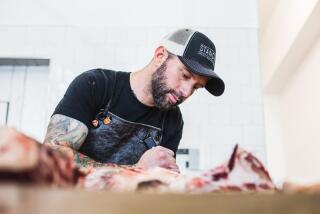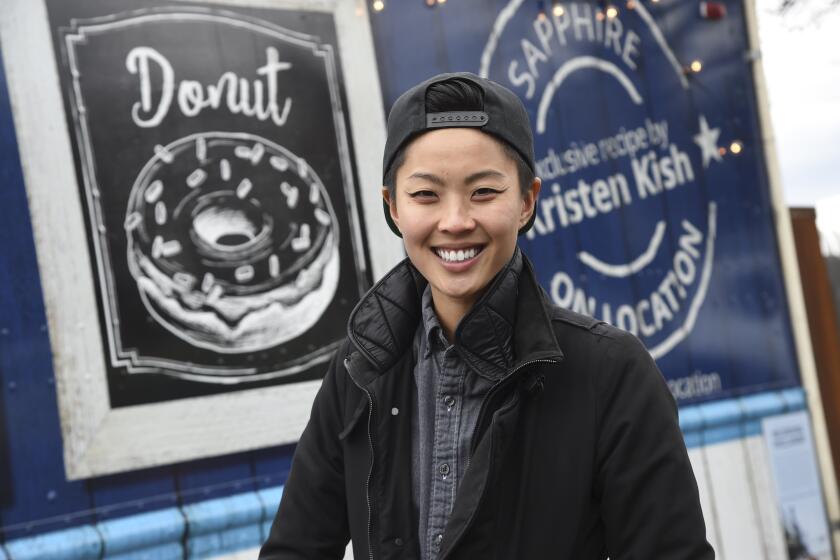FIXATIONS : The Burger Meister : * Remember those gadgets used in the ‘50s to shape ground beef into patties? Uh, well, neither do lots of people. But Joe Amster does, and he collects them.
- Share via
Joe Amster has 110 vintage hamburger presses, a world’s record he feels no one is likely to dispute.
The hamburger press, for those whose knowledge is confined to things that matter, is a gadget used in ‘50s kitchens to mold ground beef into perfect, restaurant-like patties. Then in the touchy-feely ‘60s, Americans learned they could actually use their hands to shape patties, and the hamburger press went the way of the literate newscaster. Amster, a 35-year-old Laguna Beach resident who manages Dorothy’s Thrift Shop in Costa Mesa, has presses in all shapes and sizes, including a prized Bakelite model actually shaped like a hamburger. Most, though, are made from two pieces of hinged wood, with a recessed circle into which the meat is pressed. They look as if they were born to be obsolete.
In five years of amassing presses, Amster has yet to find another collector. Indeed, when the San Francisco Chronicle ran a small article on his collection, several people contacted him, but only to see whether they could unload their old burger presses on him.
“That’s why I think I can reasonably say I have the world’s largest collection,” Amster says, “because no one has ever stepped forward to challenge me on this.”
But it is always a precarious perch at the top of the heap, and one can never be sure of supremacy where fixations are involved. Fixations is what this column is about: passions, hobbies, causes and predilections that get a bit out of hand in some people’s lives, making them unique, perhaps certifiably so.
How far folks will go in pursuit of their personal grail never ceases to amaze. I once had some hard-core record collectors over to look through thousands of surplus jukebox 45s I kept stored in plastic drums in my yard. It turned out that due to water seepage, the whole mess had gone fungoid so that the records, mostly warped anyway, were suspended in a stringy sweating goop that was like pumpkin innards, except gray. And these guys plunged their arms right into it, somehow smearing labels clean to exclaim, “Here’s a James Darren on Colpix!”
That I had a yard littered with industrial drum-fulls of diseased vinyl suggests, I hope, that I’m in no position to mock others.
In weeks to come we’ll likely have collectors of all shades and stripes, as well as a wide range of enthusiasts: city council grouses, tambourine fanatics, flat-earthers, car nuts, mayhaps a berserker or two. If you think you may qualify, let us know. After hamburger presses, we’re open to just about anything.
Amster bought his first press in 1986, while living in San Francisco, as a gag gift for a friend. Then he bought a couple for himself, then a couple more, and soon was sliding down the slippery slope of collectordom.
“I’ve always collected things that others have no use for,” he said. “And this one thrift shop near the Cow Palace made it too easy. The more hamburger presses I bought, the more they’d get in, sometimes four or five at a time.” Bonanza! He has been drawn, almost intuitively, he says, to discover burger presses in such disparate locales as Disneyland and New Orleans. He looks for signs of them everywhere, particularly in the black and white kitchen of Bub O’Casey in “My Three Sons.”
“I know he must have one. They just haven’t shown it yet,” he insists.
Most of the presses he owns were made in Japan, at a time when that nation specialized in such low-tech bric-a-brac. The best presses, in Amster’s estimation, were the ones made by the Japanese Woodpecker Woodware company. “I like to think it went on to become Sony or Mitsubishi or something,” he said.
If these presses could speak (with a voice like Strom Thurmond’s, perhaps), Amster thinks they also would say something about American life.
“Americans love gadgets, anything to make life easier,” Amster said, “Life was moving faster in the ‘50s so they needed conveniences. Maybe this was one of the great labor-saving devices of the era.”
Amster’s trove includes presses from Costa Rica, the United States and other climes, with some made of cast metal and a few more modern plastic varieties. Most, though, are the Japanese wood models, nearly all inexplicably decorated with roosters . Some have roosters fighting; more morbid models have a single rooster standing next to a hatchet. Go figure: The nation that once put poultry on a hamburger tool now owns Pebble Beach.
Amster entered his presses in the “collectibles” category of the Orange County Fair two years ago, but they found no honor there. In the 1987 San Francisco County Fair, however, he took the third-place ribbon.
“It’s sort of an urban fair, so there’s more of a tongue-in-cheek air to it,” Amster noted, adding that one of the winning entries was a framed collection of “blotter acid” LSD.
These days it takes a pretty special press for Amster to recapture the buzz of his early finds. Rarities he’s gotten excited over include a double-decker press to make two patties at once, and one which, when opened, turned out to be a Swedish meatball press.
His finds are few and far between lately.
“I used to joke I was taking the job running this thrift shop so I’d have first dibs on the burger presses,” he said. But only one has come in since the Harbor Boulevard shop (a nonprofit operation that has taken in some $60,000 for the Irvine-based AIDS Services Foundation) opened in May. And being in a thrift store all day doesn’t make him eager to go visit other ones. “It’s too much like work.”
His 110 presses currently reside in boxes in his garage, though they may rise to glory again some day. He’s been talking, he says, with the manager of a hamburger place in Santa Ana to see if the presses can be displayed there.
And which of his many presses does Amster find works the best?
“Oh, I’ve never used them at all. I find them to be pretty useless instruments. I collect them for the aesthetic value.”
It further transpires that the presses are only a sideline to Amster’s chief collecting interest: cookbooks. He has amassed more than 500 of those, with a specialization in barbecue texts. Does he, one inquires, use the cookbooks?
“No, I rarely work from recipes.”
Which leads to a question that may unfortunately come up all too frequently in this column:
“Are you nuts?”
“No,” Amster said, then gazed over his collection, lying there looking like the sad castanets of destiny. “Wait, yes, yeah, I am.”
More to Read
Eat your way across L.A.
Get our weekly Tasting Notes newsletter for reviews, news and more.
You may occasionally receive promotional content from the Los Angeles Times.










